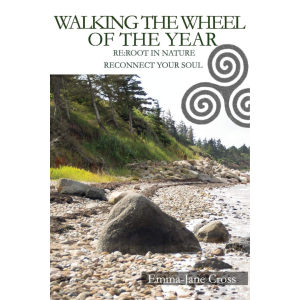By Emma-Jane Cross
Despite the best efforts of the rains and ever returning frost the blossoms are… Well they’re blooming. Which can only mean one thing: Beltane is here!
Beltane, celebrated from 30th April to May 1st, is very much a festival on the wheel of the year that is known to be of Celtic origin. Beltane is a Celtic word, a combination of the Celtic God ‘Bel’*, meaning ‘the bright one’ and the Gaelic word ‘teine’ meaning fire. Beltane is held at the peak of spring. At Beltane our Celtic ancestors wanted to encourage Bel’s support, ergo the sun, to nurture and increase the fertility of the future harvest that would ensure the survival of the community. Hence the fact that Beltane, to this day in Pagan circles and in May Day folk customs, is synonymous with fertility. So if you have been feeling a little frisky of late, you can blame that Beltane energy!
Apparently Bel had to be won over and didn’t offer his support easily, and not unlike some of my previous romantic partners, needed some encouragement. On Beltane Eve across Europe, all fires in the community were put out and two balefires were lit atop the highest hills in the town in honour of Bel. These were called the ‘Tein-eigen’ in Gaelic or ‘Coelacanth’ in Welsh, but most commonly known as a ‘Need-fire’. People would jump through the fire to purify, cleanse and bring fertility. Cattle were driven through the smoke to protect them from disease and increase their fertility and then people took some of the Need-fire home to light their hearths. In the spirit of increasing fertility, people would do their part by going “a-maying”— basically making love out in nature. Normal societal rules went out of the window and people would play with others outside the bonds of marriage. Incidentally, this was the season of marriage which to our modern eyes might seem like an oxymoron, but it worked for them. And apparently for Bel too, as we humans are still surviving today thanks to the fertility of generations of harvests and greenwood marriages!
Obviously my point is that with all the hanky-panky in the woods, blossom in the trees and homage to Bel, if we are looking through a Celt’s eyes the message of this season is fertility, union and of course fire. When I used to teach my Walking of the Wheel of the Year course in person, I used to avoid diving into the whole fertility/union energy of Beltane. Instead we focused on our relationship with ourselves through self-love practices. Which I still maintain is a great way to connect with Beltane energy. However, recently my thoughts have been returning to the fertility energy of Beltane and in particular the traditions of the Need-fire.
This could be because there are big changes happening in my life right now. I’m at a changing point in my career. And I can feel the embers of dreams from my past self emerging, with a need desperate to grow. Which got me thinking about Beltane’s fertility in a different way. We hear a lot today about being our authentic selves. Being true to ourselves and our dreams. And I am a big advocate for this. However, I recognise for many people, myself included, life gets in the way of the passions within. Perhaps what we might need is a burst of that fertile Bel Need-fire energy to enliven our passions and fertilise our dreams, giving sustenance to grow into our authentic self.
I’ll be honest with you, I had no idea on how to work with Beltane’s fertility energy in this way. But with a little google-fu and reading I found that the Celts had left some guidance, not in the form of archaeology, but in folk customs. Many of our ancestor’s rituals are hidden in folklore. In the book Folk-lore and Folk-stories of Wales by Mary Trevelyan, she observed preparations for the Need-fire on May Eve in south Wales in 1909. She wrote:
“The fire was done in this way: Nine men would turn their pockets inside out, and see that every piece of money and all metals were off their persons. Then the men went into the nearest woods and collected sticks of nine different kinds of trees.
“These were carried to the spot where the fire had to be built. There a circle was cut in the sod and the sticks were set crosswise. All around the circle the people stood and watched the proceedings. One of the men would then take two bits of oak and rub them together until a flame was kindled.”
Trevelyan. M (1909) Folk-lore and Folk-stories of Wales – London, E. Stock Pp.22-23
Now I don’t know about you but hidden under this custom I can see lashings of Celtic Beltane symbolism. The first being the removal of metal. Beltane Eve is directly opposite Samhain on the Wheel of the Year. And like Samhain, Beltane has a thinning of the veil between the worlds. This time between the worlds of humans and the fae. And what do the fae hate the most? Metal. Particularly Iron. These men were being brave, removing the metal and going into the woods without a form of protection when the fae were roaming the land.
The Nine men collecting sticks from nine trees could be a nod to the 9 sacred trees, the first nine woods named within the Celtic Tree Calendar: Alder, Ash, Birch, Hawthorn, Hazel, Holly, Oak, Rowan and Willow. And lastly, rubbing the Oak to start the fire (no metal was used to start this sacred flame; you need to work for it if you want a God’s support.) Well Oak, funnily enough, is a symbol of fertility and was part of the Celtic celebrations of Beltane. Need-fires in Ireland were apparently kept alight with acorns. So is this a leftover reference to asking Bel for fertility in the land? I’d like to think so.
To my mind our Celtic ancestors have given us very clear guidelines on how to kindle our inner fires and ask the Gods for some fertile energy. Firstly we have to be brave and in a sense vulnerable. Secondly we have to be clear on our intentions, the wood we need. Thirdly we have to put in the work. And lastly if we want Bel to support us, then a Need-fire is the way of getting his attention. Fire and wood collecting is not always easy today, I get it. But if you can’t find all of the nine woods, find some. If you can’t make a fire, burn some incense, or you can decorate your altar with some of the nine woods and light a candle, making an intentional prayer to Bel. I think he probably knows the world has changed. (Side note – If you are going to make a Need-fire, please be sensible about how and where you do it. Ergo, be safe.)
Beltane Eve for our ancestors allowed them to be free and bold. And I think it is freedom from the life that is getting in the way of my dreams, my inner needs and passions that I will be connecting with this Beltane. It’s time for me to light my Need-fire and channel the energy of Beltane’s fertility into my dreams, knowing that I will have to put in the work and rub my sticks
to get that fire started. I mean, the farmers still had to work on the crops the day after Beltane! If you have a spark inside of you longing to be free there really is no better time than Beltane to be brave, free it and connect with Beltane’s energy to fertilise it and enable it to grow and blossom, following the inspiration of our ancestors who lit the Need-fires centuries before us.
*Also known as Belimawr, Bel, Belenos, Belinos, Belinu, Bellinus, and Belus.
MEET THE AUTHOR
EMMA-JANE CROSS is a spiritual coach and author specialising in creating spiritual connection with nature and the wheel of the year. Her roots are in Celtic and Norse traditions, from her Welsh childhood, her training in Shamanism, Druidry and Witchcraft at Avebury, and her work as Viking historical-interpreter within Scandinavian Museums. From her home by the fjord Emma-Jane guides people worldwide to rekindle a spiritual connection and personal growth journey aligned with nature’s seasons. She teaches workshops in Denmark and online at www.rerootcourses.podia.com and regularly speaks and teaches Celtic spirituality, earth magic and seasonal spirituality at events.
On the web
Bookshelf
WALKING THE WHEEL OF THE YEAR: RE:ROOT IN NATURE, RECONNECT YOUR SOUL BY EMMA-JANE CROSS, published by Green Magic, paperback (210 pages).




